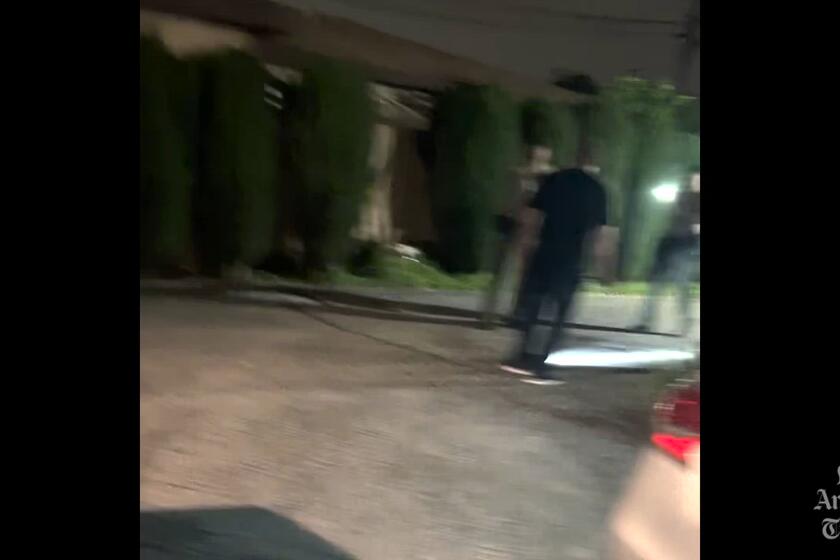Triumph From Trivia : Tax Data Study Pays Off for Calabasas Cityhood Activists
Robert Hill knows how many people, on an average week, sleep at the Good Night Inn.
Doris LaViolette can recite how many cars are bought each month by customers of the Acura car dealership.
Dennis Washburn knows how much sales tax is generated by the steak, shrimp, barbecue ribs and other items at the Red Robin Restaurant.
Worthless, seemingly trivial knowledge? Not to the community activists who have devoted hundreds if not thousands of hours in the drive to create a separate city in Calabasas. Figures such as these became crucial after a report written by the staff of the Local Agency Formation Commission, also known as LAFCO, in April predicted financial ruin for the proposed city.
Convinced that the report was unrealistically bleak, the cityhood supporters recently launched what amounted to a community treasure hunt to collect any and all financial statistics to support their contention that this panoramic outpost of expensive homes could be self-sufficient.
In their search on foot, car and by phone, the members spotted 260 businesses in the community and obtained sales-tax figures from some of the newest and largest arrivals. The sales-tax revenue from the newer businesses was not included in LAFCO’s report because the staff relied on 1985-1986 data. But those big tax producers, which included the Acura and Mitsubishi dealerships and the Good Night Inn, made the difference in the bottom line.
Combing through microfiche, the group also compiled a list containing the property taxes assessed to each parcel in Calabasas. This search uncovered a much healthier potential property-tax revenue than LAFCO had projected from the out-of-date data.
It was this exhaustive search for fiscal details that apparently helped provide the Calabasas Cityhood Study Committee with a stunning victory last week. In a surprise move, LAFCO commissioners tentatively approved the 14-square-mile proposed city despite being urged to defeat it by LAFCO’s executive director, Ruth Benell.
“We were real thorough,” said Marvin Lopata, the committee’s treasurer. “I think the commissioners knew we had done our homework.”
Benell had predicted that the city would experience a first-year shortfall of $1 million in its budget, but the cityhood boosters, using the fresher data, suggested that the city would actually enjoy a surplus of nearly $700,000.
The commissioners, in complimenting the cityhood supporters, credited the fact-gathering effort for swaying their opinion.
“The Calabasas committee as a group of lay people undertook an extraordinary amount of work to pull the material together,” Los Angeles City Councilman Robert Farrell said. The councilman served as an alternate for City Councilman Hal Bernson at last week’s LAFCO meeting when the cityhood vote was taken.
Other Factors
But others suggest there are equally weighty factors behind the Calabasas boosters’ preliminary victory.
Supporters of a similar incorporation effort in Santa Clarita Valley, for instance, say they do not believe the Calabasas group’s research was any more definitive than theirs. Relying on a certified public accountant, the Santa Clarita group produced a lengthy report--Calabasas’ was only three pages--to support its request that LAFCO reconsider reducing the proposed city by half. Their effort this spring was unsuccessful, although LAFCO did grant approval for a proposed city of smaller proportions.
In the Calabasas case, observers also noted the dearth of opposition from developers, who have been known to lobby against incorporation efforts in booming areas of Los Angeles County. That potential confrontation was avoided in May, when LAFCO decided to scale down the 26-square-mile city. The 12 miles that were excluded represented most of the virgin chaparral-dotted lands that developers covet.
Some also theorize that the raging controversy enveloping the incorporation effort in the Santa Clarita Valley and the recent publicity that the relatively obscure commission has received in news reports affected the outcome.
“I’ve had it suggested to me one reason they had such smooth sailing is because we were given such a tough time,” said Connie Worden, vice chairwoman of the Santa Clarita City Formation Committee. “Certainly, sympathy for proponents had been established. As long as there wasn’t a detrimental effect on the county, the feeling was, why not let these people go?”
Benell and LAFCO commissioners, however, discounted that theory.
“I don’t think my commission is intimidated by Santa Clarita one bit,” Benell said.
Field Trip Helped
The cityhood backers also believe the tide turned in their favor when several commissioners took field trips to Calabasas. At least two commissioners visited the burgeoning community on their own, while cityhood supporters gave another commissioner, Henri F. Pellissier, a blue-ribbon tour.
The tour guides pointed out the new businesses that would generate income for Calabasas and also noted what facilities the community lacks because of neglect by Los Angeles County.
Dennis Washburn, a committee officer on the tour, recalls Pellissier’s asking to be driven past the community’s senior-citizen center.
“We told him we didn’t have one,” Washburn said. “We don’t have any parks out here, either.”
Actually, they did show him the closest thing to a park in Calabasas: a patch of vacant land, six-tenths of an acre that the county owns.
“That visit was one of the eye-openers,” Washburn noted.
LAFCO has directed Benell to check the cityhood group’s figures and report back in August. If the data is sound, they will forward the incorporation request to the Board of Supervisors for a hearing and a vote. A city election could take place as early as spring.
Benell said she was not ruffled by the commission’s decision to ignore her recommendation. She said she used the 1985-1986 figures because they were the last complete year available.
With a full-time staff of two, Benell said she cannot constantly revise incorporation figures. She also questioned the wisdom of relying on current revenue numbers while merely projecting what expenditures would be.
“If you use 1985-1986 expenses and 1987-1988 revenues in order to get a true picture, . . . you have to use the same time frame,” she said.
The proposed city of 21,000 would be bounded by Woodland Hills on the east and Agoura Hills on the west. The city would encompass Calabasas Highlands, Calabasas Park, Malibu Canyon Park, Mulwood and Saratoga Hills.
More to Read
Start your day right
Sign up for Essential California for news, features and recommendations from the L.A. Times and beyond in your inbox six days a week.
You may occasionally receive promotional content from the Los Angeles Times.






